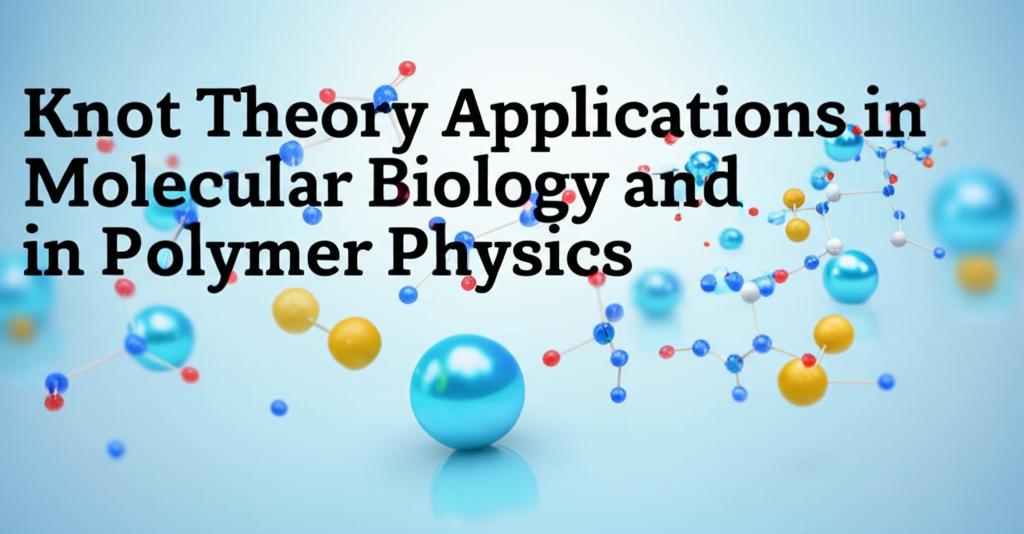Knot theory, a branch of topology, has found surprisingly powerful applications in understanding the complex structures and behaviors of biological macromolecules and polymers. This mathematical field, which studies the properties of knots and links, provides a unique lens through which scientists can analyze the entanglement and topology of long chain-like molecules such as DNA, RNA, proteins, and synthetic polymers.
Unraveling DNA's Complex Knots
One of the most significant applications of knot theory in molecular biology lies in the study of DNA. DNA molecules, especially within the confined space of a cell nucleus or viral capsids, can become incredibly long and tangled. These topological complexities are not mere curiosities; they play crucial roles in fundamental biological processes.
Enzymes like topoisomerases and recombinases actively manage the topology of DNA. They can cut, pass, and religate DNA strands, effectively tying and untying knots or linking and unlinking circular DNA molecules. Knot theory helps researchers to:
- Characterize DNA Knots and Links: By representing DNA strands as mathematical knots, scientists can classify the types of knots present (e.g., trefoil knot, figure-eight knot) and quantify their complexity. This is often achieved by analyzing images from electron microscopy or through computational simulations.
- Understand Enzyme Mechanisms: The changes in knot type or linking number (a measure of how many times two closed DNA circles are intertwined) before and after an enzyme acts on DNA can reveal precise details about the enzyme's mechanism. For instance, it can indicate whether an enzyme passes one or two DNA strands through another.
- Study DNA Packing and Condensation: Knot theory provides insights into how extremely long DNA molecules are efficiently packed within small volumes, such as in cell nuclei or viral capsids. The formation of specific knot types can be an indicator of the packing process and the forces involved.
- Investigate DNA Replication and Recombination: During processes like DNA replication and recombination, transient knots and links are formed and resolved. Understanding these topological changes is essential for comprehending these vital cellular functions. For example, the degree of catenation (linking) of daughter DNA molecules after replication provides information about the termination process.
Deciphering Protein Structures and Folding
Proteins, with their intricate three-dimensional structures, also present opportunities for topological analysis using knot theory. While true knots in the backbone of a single polypeptide chain are relatively rare (though they do exist and are functionally significant in some proteins, known as "knotted proteins"), the concept of entanglement and non-covalent "slipknots" is more common.
Applications include:
- Identifying Knotted Proteins: Knot theory algorithms can detect if a protein's backbone is knotted. The presence of a knot can contribute to a protein's stability, folding pathway, or function. Identifying these knots helps in understanding their evolutionary origins and biological roles.
- Analyzing Protein Folding Pathways: The study of how a protein chain navigates its complex energy landscape to reach its native, functional state can be informed by topological considerations. Knot theory can help describe the entanglement present in unfolded or partially folded states and how this entanglement is resolved or maintained during folding.
- Understanding Protein Stability and Dynamics: The topological state of a protein, including the presence of deep knots or complex entanglements, can significantly impact its mechanical properties, resistance to unfolding, and its dynamic behavior.
Exploring Polymer Physics and Material Science
In polymer physics, knot theory is instrumental in describing the statistical and mechanical properties of long-chain polymers, both natural and synthetic. Polymers in solution or in a melt can adopt a vast range of configurations, and their entanglement is a key determinant of their macroscopic properties.
Key applications are:
- Characterizing Polymer Entanglement: In concentrated polymer solutions and melts, chains inevitably become entangled. Knot theory and related topological concepts like linking number and writhe help quantify this entanglement. This is crucial for understanding rheological properties like viscosity and elasticity.
- Modeling Polymer Dynamics: The movement of polymers, particularly reptation (snake-like motion of a chain through a tube formed by its neighbors), is heavily influenced by topological constraints. Knot theory contributes to models that predict how polymers flow and respond to stress.
- Phase Transitions and Material Properties: The probability of knot formation in a polymer chain can depend on factors like solvent quality and temperature. Changes in knotting probability can be associated with phase transitions, such as the coil-globule transition. The presence and type of knots can also influence the strength and elasticity of polymeric materials.
- Topological Glass Transition: Recent research explores the idea that in dense systems of unknotted ring polymers, the inability of rings to pass through each other without breaking can lead to a dynamically arrested state, akin to a glass transition, driven purely by topological constraints.
Future Perspectives
The application of knot theory in molecular biology and polymer physics is a rapidly evolving field. Advances in computational power, experimental techniques (like single-molecule manipulation and advanced microscopy), and theoretical tools are continuously expanding the frontiers. Future research is likely to focus on understanding the interplay between topology and function in more complex biological systems, designing novel biomaterials with specific topological properties, and further unraveling the mechanisms of molecular machines that manipulate topology. The development of new topological invariants and algorithms will also continue to provide deeper insights into the fascinating world of molecular knots and links.

